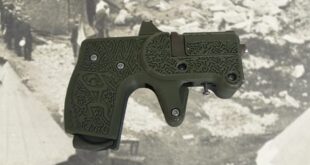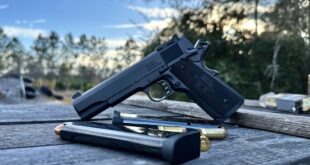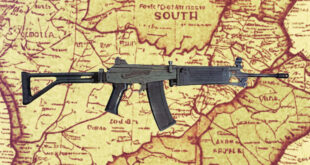Springfield Armory’s XD (M) 5.25 Pistol
Bob Pilgrim
From the January 2012 issue of SOF
Competition and Combat
Although bred for the various competitions of the action shooting genre, it is the author’s contention that Springfield Armory’s latest polymer pistol, the 5.25 XD(M) in 9×19 mm would perform, with minor changes, equally as well as a SWAT officer’s sidearm.
When the FBI Hostage Rescue Team (HRT) first wrote the specifications for its first 1911-style pistol, they required that it deliver one-inch groups at 25 yards. The theory behind that degree of precision is that the more accurate the pistol, the more forgiving it would be when the operator committed a shooting error or was unstable during a hostage rescue shot.

are similar externally as well as in handling and shooting. G 34 has aftermarket TAC-Grip.
Pistol’s Prominent Role Diminished
Initially, the pistol enjoyed a special place among the personal weaponry of the HRT operator. It served as both a secondary and primary entry weapon. In extremely tight close quarter battle environments, such as aircraft, trains and buses (tube fighting), it was the lead entry and maneuver weapon. It was especially valued because the pistol literally went everywhere, whereas the carbine or submachine gun sometimes impeded movement in the conveyance’s aisles. Entry personnel armed with pistols often carried two handguns, embracing the SEAL admonition of “One is none, two is one.” However, in the past several years this has changed somewhat with the advent of personal defense weapons (PDW) and micro carbines in 5.56x45mm. Now tier one operators charge through narrow passageways with optically enhanced and often suppressed stunted shoulder weapons in the same caliber as their full size assault carbines. As a result, these tier one teams have permanently relegated pistols to a support or backup mission and the original accuracy requirements have been further relaxed.
Transition from Metal to Plastic Guns
I carried an issue 1911 A1 throughout 32 months of heat, mud, water and humidity of Southeast Asia and with minimal care it never failed me. It was as loose as a baby rattle, but accurate enough for the type of combat America has experienced since the Philippine Insurrection. Now the military has an alloy framed pistol that is controversial along with its caliber, but tier one units like Delta and HRT have opted for all steel pistols in .45 ACP to help them in their counterterrorist roles.

With few exceptions and those guns usually are tack drivers, most polymer guns are considered combat accurate. This is mainly due to its barrel and slide interface or lockup. Like the original FN P35 pistol, these handguns have linkless barrels and lock up at only one point in the slide—the breech. 1911-style pistols with rotating links have three points of barrel support: the link, the barrel lugs and the barrel bushing. As a result, barrel movement out and back into battery is more consistent. When 1911s are properly tuned and mated to a good barrel, accuracy is outstanding. Gunsmiths have learned to combine this accuracy with reliability and these are two of the reasons that two federal counter terrorist units and many SWAT teams have opted for the 1911 pistol.
Before FBI HRT adopted the 1911, it was wedded to the all steel FN Browning High Power 9×19 pistol. With its linkless barrel, it was no slouch in the precision department. Over a period of time, polymer-framed pistols incorporated various accuracy enhancing features such as match barrels, muzzle–slide interface support, enlarged or belled muzzles, tighter fitting locking blocks and trigger over travel stops to enhance lockup and accuracy. Larger fore and aft frame rails also provide more side support while cycling. We now see polymer pistols that, when fed a diet of quality ammunition, deliver minute of angle (MOA) accuracy at 25 yards. Today’s operators, who primarily look upon the handgun as a back up weapon, agree that several brands of polymer-framed pistols are sufficiently accurate to fulfill that role on hostage rescue missions and can indeed “thread the needle” at close quarters combat ranges.
Multiple Safeties
This is a point and shoot pistol with multiple active and passive safeties. Most prominent and unique to this polymer handgun is its 1911-style grip safety. Also visible and requiring a purposeful act is the gun’s trigger safety. This is backed up by a loaded chamber indicator that does not necessarily eliminate the need for a chamber press check and a striker status indicator. Internally, a striker safety block prevents the fully compressed striker from being released unless the grip and trigger safeties are depressed in concert.
XD (M)’s Ascendancy
Once again, Springfield Armory and its Balkan brothers have created another esthetically pleasing M-series polymer pistol in the form of its latest iteration, the XD M 5.25 Competition model in 9x19mm. Heavily influenced by shooting champion Rob Leatham and specifically designed for International Defensive Pistol Association (IDPA) and United States Pistol Association / International Pistol Shooting Confederation (USPA/IPSC) venues of action shooting, special operations forces nevertheless have recognized its utility as a tactical operations firearm.

Without becoming embroiled in the negative arguments that often surround the 9×19 mm round, it is appreciated that in some of its more potent +P and +P+ controlled expansion loadings, it can be a very effective anti-personnel caliber. Velocity is considered to be the nine’s friend and the 5.25 XD M’s fully supported barrel certainly enhances that by giving propellants a longer runway to complete their burn and exert a more prolonged influence on the departing bullet. Although I prefer fixed sights on a service weapon, its melted and sturdy adjustable rear sight is necessary to accommodate the sheer variety of 9×19 mm loads on the market. Its longer sight radius and red dot fiber optic front sight enhance sighting, sight recognition and sight tracking. While the fiber optic front sight presents a potential snagging problem, it can be readily changed to a ramped blade. Having said all this, Springfield has already announced it is shipping .45 and .40 caliber pistols.
Race Ready
Contained in a tough and lockable plastic attaché case, with three 19-round magazines, holster, magazine pouch, magazine loader and different sized and interchangeable backstraps, the 5.25 is ready to step up to the firing line right out of the box. Of course it has to be sighted in for the specific load, but it is fully equipped to race right out of the box. Also included are a manual, sample shell casing for various jurisdictions, Allen wrench, nylon cleaning brush and cable security padlock.
Its frame is aggressively checkered for a no-slip grip, with its grip angle similar to the 1911 Government Model; it points naturally for many shooters. Port and starboard relief cuts permit access to its trigger without contacting the receiver or the ambidextrous safeties. They also provide the thumb with a convenient and proper location for thumb placement.
Ballistic Performance
With one exception, all 147-grain subsonic rounds went supersonic in its extended barrel. With a .95 inch group at 25 yards, accuracy honors went to surplus 95-grain British military ammo that was produced for its special forces by Federal and supplied to me by Ammunition to Go some time ago. Atlanta Arms Ammunition has provided the US Army’s Marksmanship Training Unit with match pistol loadings for many years. Their “.335 Super”125-grain match ammunition achieved a high velocity of 1384 feet per second (FPS) for 535 foot pounds of muzzle energy and a power factor of 173.625. I compared this performance with the Glock 34’s polygonal rifling and the XD amply demonstrated its gas sealing and reduced bullet drag superiority to conventional borings. The 5.25’s Austrian counterpart pushed the same round to 1402 fps, with an average velocity of 1395 fps. However, it was noted that the Glock’s barrel to breech face is 5.325 inches and the XD M’s is slightly shorter at 5.27 inches. However, I wasn’t finished yet in the hyper velocity pursuit. A late arrival from boutique ammo producer Buffalo Bore was subsequently tested and its 115 grain +P+ JHP clocked a high velocity of 1404 fps (503 ft. lbs.) and turned in a five-round cluster of 1.90 inches. However, highest run across the chrono’s sky screens went to Corbon’s 90-grain Jacketed Hollow Point (JHP) of 1585 fps. None of the other rounds fired through the 5.25 achieved USPA/IPSC’s major power factor of 165.
Long Range Accuracy
Its long range precision with ammunition it favored was hostage rescue worthy. Since this is a pistol bred for competition and is also being considered to serve as a SWAT sidearm in this article, as well as in the interest of space, only those rounds that grouped below four inches are listed in the chart.
Close Combat
Even though its trigger has some creep, it breaks cleanly at six pounds; it is heavy for competition and some SWAT operators may also prefer to have it lightened a bit. Its trigger travel has a shorter reset than the XD, but I don’t notice the difference between the “M” and my standard XD in .45 ACP. However, at typical close combat ranges, the 5.25 is a speed shooting dream. It handles recoil so well that seven-yard, two-second Bill Drills become the norm and accuracy-preserving sub .20 second splits are almost effortless to achieve. Fiber optic sight recognition is extremely quick. Normally, I pull my shots to the left when burst shooting with a pivoting trigger, but not with the 5.25. My primary dispersions were vertical with lateral spread well within the A zone’s borders of an IDPA target. This was achieved with Federal 115 FMJ ammo clipping along at 1200 + fps. Reliability with all rounds fired was 100 percent.

In addition to their shooting characteristics, all XD’s excel at simplicity and safety of disassembly. Using a disassembly lever design borrowed from SIG Sauer, slide removal is a breeze; the XD(M) model does not require its trigger to be pulled.
XD M 5.25 Competition Performances
| Ammunition | Velocity | Groups | Standard Deviation |
| Atlanta Arms Ammunition | |||
| 125-gr. .355 Super JHP | 1381 | 3.62 | 3 |
| Black Hills 115-gr. +P JHP | 1320 | 3.58 | 27 |
| 147 gr. FMJ | 982 | 2.13 | 9 |
| Buffalo Bore 115-gr. +P+ JPH | 1399 | 1.9 | 5 |
| Corbon 90-gr. JHP | 1585 | 3.45 | N/A |
| Powerball 100-gr. | 1508 | 2.62 | 23 |
| Federal 95-gr. PSP | 1350 | .95 | 2 |
| 115-gr. FMJ RN | 1244 | 2.32 | 4 |
| Hornady 115-gr. FTX Critical Defense | 1130 | 1.70 | 2 |
| International 100-gr. HP | 1261 | 1.85 | 5 |
| Speer 147-gr. GDHP | 1061 | 1.44 | 10 |
| Wilson 115-gr. XTP JHP | 1312 | 1.29 | 18 |
| Winchester 100-gr. PSP | 1371 | 1.58 | 16 |
| 115-gr. FMJ | 1253 | 3.12 | 12 |
| 115-gr. STHP | 1231 | 2.19 | 3 |
| 147 gr. SS JHP | 1023 | 1.84 |
Average five-round groups were obtained from a hand held rest at 25 yards. Average five-round velocities were obtained with a Pro Chrono chronograph 10 feet from the muzzle. Temperature = 90 degrees.
Abbreviations: HP = hollow point. JHP = jacketed hollow point. PSP = pointed soft point. FMJ = full metal jacket. RN = round nose. STHP = silver tip hollow point. SS JHP = sub sonic jacketed hollow point. GDHP = Gold Dot hollow point. XTP JHP = Extreme Terminal Performance jacketed hollow point. FTX = flex tip expansion.
 XD M 5.25 Specifications
XD M 5.25 Specifications
Caliber: 9x19mm
Action: Striker-fired, delayed blowback
Capacity : 19 +1
OAL: 8.3”
OAH: 5.75”
OAW:
Wt., empty: 25.4 oz.
Magazine: 3 oz. (three included)
Wt., loaded: 36.8 oz. (20 rds. 115-gr. FMJ)
Frame: Black polymer
Slide: Forged steel, with lightening cut. Melonite finish
Barrel: 5.27”, 1:10 right hand twist
Sights: Full adjustable rear, red fiber optic front with replaceable green filament.
Sight radius: 7.25”
Trigger: Ultra Safe Assurance with trigger safety.
Trigger pull: Six pounds
Magazine release: Ambidextrous
Under barrel accessory rail
Size-specific interchangeable backstraps
Safeties: Grip safety, loaded chamber indicator, striker status indicator, striker block safety, trigger safety
Colors: Black. Bi-Tone
Cost: $795.00
Warranty: Limited lifetime
Conclusions
With minor modifications, the XD(M) 5.25 Competition Series would be an ideal polymer pistol for military police operations in any caliber. Its additional barrel length enhances performance in all defensive calibers. I am aware of Springfield Armory’s reasons given for the “lightening cut” in the slide, but I would prefer a solid slide with more weight at the muzzle. This will further differentiate the 5.25 from its Glock counterpart and further reduce muzzle rise. The vast majority of shooters cannot beat the rate of slide reciprocation; slowing it down with added mass would not have a significant impact on speed shooting. This is a very attractive piece at an attractive price that leaves much room at the retail level for selective shopping providing it is available. Springfield Armory has just announced that the 5.25 is available in .40 S&W and .45 ACP.
Springfield Armory
420 West Main St
Geneseo, IL 61254
800-680-6866
[email protected]
www.springfield-armory.com
 Soldier of Fortune Magazine The Journal of Professional Adventurers
Soldier of Fortune Magazine The Journal of Professional Adventurers





